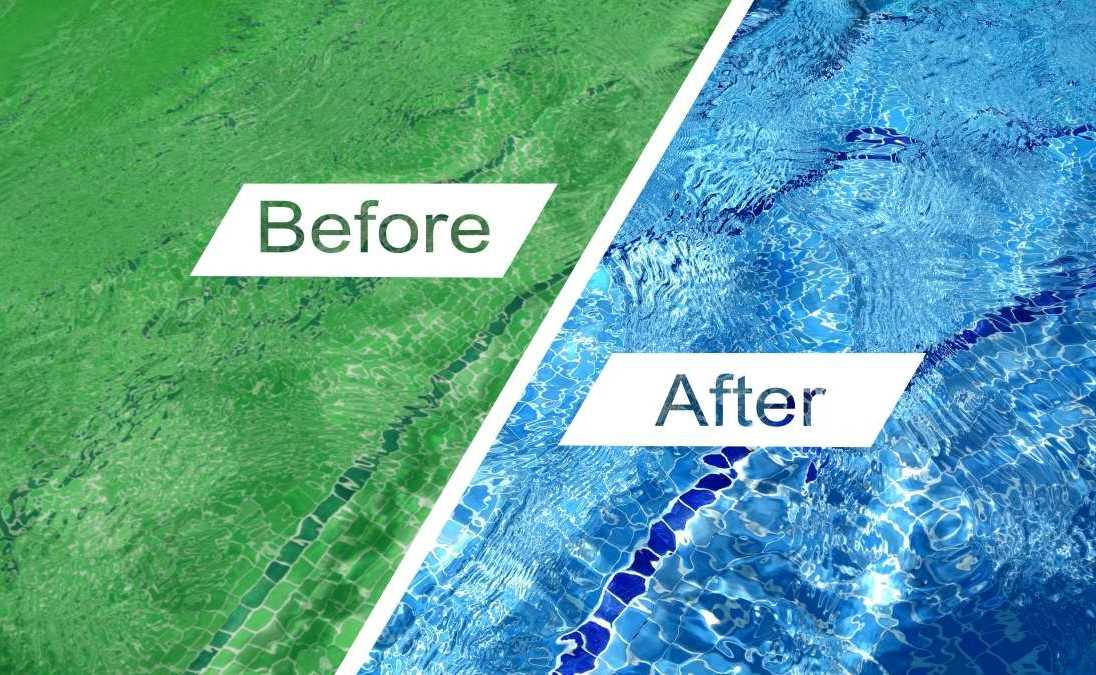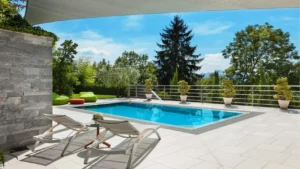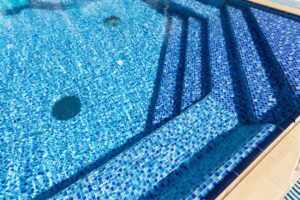Owning a swimming pool is a lot of fun, but it requires regular maintenance. Have you recently encountered any pool issues?
Don’t be disheartened. It’s unavoidable. You can only avoid the most common problems by being aware of them. We will provide you with all of the information on swimming pool problems and solutions right here. What can you expect to see if you own a pool?
Top 10 Common Pool Problems and How To Fix Them Properly
Green water

You’re dealing with an algae infestation if your pool’s surface appears green. A deficiency in chlorine is the most likely culprit.
Fortunately, this is one of the most popular pool problems. To identify the cause, test the water in your pool. After shocking your pool to kill the algae, you’ll need to brush the walls and pool’s surfaces to get rid of the dead organisms, then vacuum everything up to get your pool back to normal.
Until you complete the procedure, the pool won’t be accessible. Believe us. You won’t ever neglect to test the water again.
⇒ How about self-cleaning pool?
Filter clogged
Pool cleaning is the responsibility of pool filters. It’s important to thoroughly clean the filter if debris begins to accumulate in your pool and the filter becomes clogged.
The filter should then be prepared to once again clean the pool, so this is actually not a big deal. Filter clogs simply demonstrate that the filter is doing its job and keeping the pool clean.
Cloudy water
This is also a common pool problem for everyone is facing, when you go to use your pool, the water doesn’t appear to be crystal clear; instead, it appears to be covered in a cloud of fog. The accumulation of bacteria in your pool is the most likely reason.
As was the case with algae, missed tests that would have revealed the pool’s lack of chlorine, which kills bacteria, are the most likely culprit. Test the water in your pool and add chemicals as needed.
Cracks appear
Your pool may have structural or foundational cracks. A foundational crack can cause a variety of problems and will require more than a little do-it-yourself.
Determine the origin of the crack first. Not all the time does it imply that your pool is or will be leaking.
But these cracks may develop as a result of poor installation or a shifting foundation. It’s typically best to seek professional guidance in this situation.
Low or high pH

Water in swimming pools should have a pH between 7.2 and 7.6. The skin, throat, and eyes of pool users will become irritated if the pH is above or below this range. When you test the pool, the pH level is discovered, and you can adjust it as necessary with pool chemicals.
I hope you’re starting to see how important frequent testing is. The last thing you DO NOT want to happen at your pool is everyone to complain about their skin and eyes being red and burning when they get out of the pool.
=> You might need the swimming pool water treatment system.
A Scratchy Surface
Have you ever gotten out of the pool to find your toes bloody or sore? That’s because it is! A scratchy pool surface is harmful to a swimmer’s feet and bathing suit.
The scratchy surface could be the result of whoever installed your pool and the material they used. However, calcium buildup is more likely to be the cause. The same pH test is used to determine this.
Calcium Accumulation
There are two possibilities here: calcium carbonate or calcium silicate. In your pool, carbonate causes white flaky scales to form. Silicate produces white-grey scales.
Silicate is even worse. This could indicate that you have a leak in your pool’s foundation, with a build-up in other areas. It takes longer to form, implying that its existence has been longer.
Carbonate is a simple substance to remove.
Calcium levels in your pool should be between 200 and 400 ppm. The greater the number, the more common calcium deposits are.
Scrubbing, pumice stone, or calcium remover can be used to remove silicate. Carbonate requires the same treatment, but because the deposits aren’t as heavy, the process should be simpler.
The pool liner is coming off the track
As the pool liner ages, it is common for it to pull out of the track. With age, the liner becomes stiffer and less stretchy, and it shrinks.
The corner is a common location for the liner to pull away. You will need to boil a large amount of water to try to fix this. Pour boiling water directly on the pulled-away area of the vinyl. The hot water will stretch the vinyl enough for it to fit back into the coping.
For a few seconds, the boiling water will make the vinyl too hot to touch. Once you can handle it, you must work quickly to replace the vinyl before it cools enough to be unworkable.
=> Related article: When to replace your pool liner?
Worn O-ring

The pool pump and filter O-rings must be checked for wear on a regular basis. The large O-ring located between the filter head and filter body is the one that wears the most and may need to be replaced. This should be checked every time the filter is cleaned. Look for signs of wear, such as cracks, rips, or tears.
A faulty O-ring will allow water to leak from the filter, causing costly damage to the pool equipment. To extend the life of the replacement O-ring, apply a silicone-based lubricant to it before installation.
The Underground Pool Is Emerging Above Ground
Ultimately, this is an extremely rare situation of pool problem. Concrete pools can make it happen, though.
If you notice your pool rising, or “popping,” above the surface, you may have a pooling problem. Not your actual pool, either; excess water may be pooling beneath the surface, shifting it upwards.
Allow your pool to relieve pressure by draining it downhill or opening the relief valves located at the pool’s bottom. Of course, this is most likely a professional job.
Pool Solutions? Contact Blue Pool and Spas!
Understanding swimming pool problems and solutions to keep up with pool maintenance is the key to minimizing problems and costly repairs to your pool and equipment. Spending a few minutes each day to test the water and another few minutes to add chemicals as needed will save you hours of cleaning later.
Don’t be afraid to seek professional assistance. Don’t ignore anything that doesn’t seem right. Be proactive and don’t let minor issues turn into large and potentially costly repairs.








